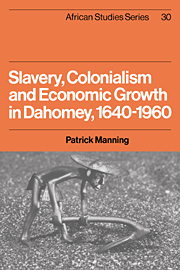Book contents
- Frontmatter
- Contents
- Maps
- Tables
- Figures
- Preface
- 1 Slavery, colonialism and economic growth, 1640–1960
- 2 The Dahomean economy, 1640–1890
- 3 Struggles with the gods: economic life in the 1880s
- 4 Production, 1890–1914
- 5 Demand, 1890–1914
- 6 Exchange, 1890–1914
- 7 The alien state, 1890–1914
- 8 Social struggles for economic ends, 1890–1914
- 9 The mechanism of accumulation
- 10 Capitalism and colonialism, 1915–60
- 11 The Dahomean national movement
- 12 Epilogue
- Notes
- Appendix 1 Export revenue from Dahomey, 1640s–1950s
- Appendix 2 Slave exports by ethnic origin
- Appendix 3 Population loss due to slave exports
- Appendix 4 Foreign trade of Dahomey
- Appendix 5 Foreign trade indices
- Appendix 6 Rainfall
- Appendix 7 Fiscal flows
- Appendix 8 Money supply of colonial Dahomey
- Bibliography
- Index
2 - The Dahomean economy, 1640–1890
Published online by Cambridge University Press: 26 October 2009
- Frontmatter
- Contents
- Maps
- Tables
- Figures
- Preface
- 1 Slavery, colonialism and economic growth, 1640–1960
- 2 The Dahomean economy, 1640–1890
- 3 Struggles with the gods: economic life in the 1880s
- 4 Production, 1890–1914
- 5 Demand, 1890–1914
- 6 Exchange, 1890–1914
- 7 The alien state, 1890–1914
- 8 Social struggles for economic ends, 1890–1914
- 9 The mechanism of accumulation
- 10 Capitalism and colonialism, 1915–60
- 11 The Dahomean national movement
- 12 Epilogue
- Notes
- Appendix 1 Export revenue from Dahomey, 1640s–1950s
- Appendix 2 Slave exports by ethnic origin
- Appendix 3 Population loss due to slave exports
- Appendix 4 Foreign trade of Dahomey
- Appendix 5 Foreign trade indices
- Appendix 6 Rainfall
- Appendix 7 Fiscal flows
- Appendix 8 Money supply of colonial Dahomey
- Bibliography
- Index
Summary
THE MYTHIC ERA, TO 1660
By the late seventeenth century Dahomey had become populous, had developed sizeable states, and had an economic organization which can be characterized as including familial and commodity exchange modes of production, with a mercantile system linking it to other economies. In Dahomey and throughout the Bight of Benin, the major ethnic groups were well established in their present positions: such migrations of families and ethnic groups as took place subsequently have done little to change the geographical distribution of Aja–Ewe, Yoruba, Voltaic and other groups. The patrilineal social structure of the seventeenth century was that of succeeding centuries. The kingdoms of Hueda, Ardra and Oyo were the largest and best known, but European observers knew many smaller kingdoms and noted that all the Aja peoples had a common political structure, though with variations in scale. The agricultural economy relied on fairly intensive land use, with yams and maize as staples. Millet, sorghum, beans and sweet potatoes were also cultivated, along with oil palms, coconuts, oranges, pineapples and other fruits. Fishing occupied a significant minority of the population, and domestic animals included poultry, goats, sheep and cattle. The producers were tied together through a network of local markets, and used cowries as currency. The local markets were tied to more distant regions through caravans on the land and through large canoes on the lagoons and along the coast.In sum, seventeenth-century society resembled nineteenth- or even twentiethcentury society in many details.
- Type
- Chapter
- Information
- Publisher: Cambridge University PressPrint publication year: 1982



